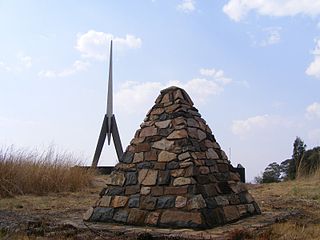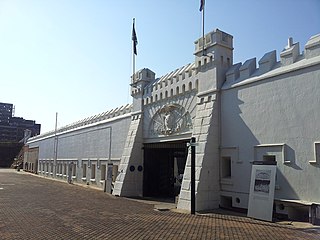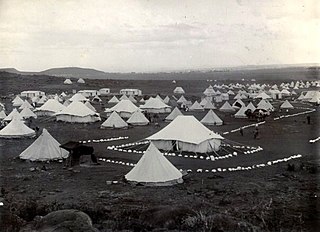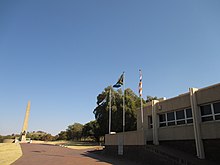
The Second Boer War, also known as the Boer War, the Anglo–Boer War, or the South African War, was a conflict fought between the British Empire and the two Boer Republics over the Empire's influence in Southern Africa from 1899 to 1902.

Bloemfontein, also known as Bloem, is the capital and the largest city of the Free State province in South Africa. It is often, and has been traditionally referred to, as the country's "judicial capital", alongside the legislative capital Cape Town and administrative capital Pretoria, although the highest court in South Africa, the Constitutional Court, has been in Johannesburg since 1994.

Ladysmith is a city in the Uthukela District of KwaZulu-Natal, South Africa. It lies 230 kilometres (140 mi) north-west of Durban and 365 kilometres (227 mi) south-east of Johannesburg. Important industries in the area include food processing, textiles, and tyre production. Ladysmith is the seat for both the Alfred Duma Local Municipality and Uthukela District Municipality.

Potchefstroom, colloquially known as Potch, is an academic city in the North West Province of South Africa. It hosts the Potchefstroom Campus of the North-West University. Potchefstroom is on the Mooi Rivier, roughly 120 km (75 mi) west-southwest of Johannesburg and 45 km (28 mi) east-northeast of Klerksdorp.
Brandfort, officially renamed Winnie Mandela in 2021, is a small agricultural town in the central Free State province of South Africa, about 60 km northeast of Bloemfontein on the R30 road. The town serves the surrounding farms for supplies and amenities. It is well known for once being home to the anti-apartheid stalwart and wife of Nelson Mandela, Winnie Mandela, during her banishment.

Winburg is a small mixed farming town in the Free State province of South Africa.
Heilbron is a small farming town in the Free State province of South Africa which services the cattle, dairy, sorghum, sunflower and maize industries. Raw stock beneficiation occurs in leisure foods, dairy products and stock feeds. It also serves as a dormitory town for the Gauteng metropolis.

Belfast is a small town in Mpumalanga Province, South Africa. It is situated in the eMakhazeni Local Municipality in the Nkangala District Municipality.

The Constitution Hill precinct is located at 11 Kotze Street in Braamfontein, Johannesburg near the western end of the suburb of Hillbrow. Constitution Hill is the seat of the Constitutional Court of South Africa.
Lichtenburg is a town situated in North West Province, South Africa. It is the administrative centre of Ditsobotla Local Municipality.
Opposition to the Second Boer War occurred both within and outside of the British Empire. Among the British public, there was initially much support for the war, though it declined considerably as the conflict dragged on. Internationally, condemnation of Britain came from many sources, predominately left-wing and anti-imperialist ones. Inside Britain influential groups, especially based in the opposition Liberal Party formed immediately. They fought ineffectually against the British war policies, which were supported by the Conservative Party of Prime Minister Salisbury.

The Medalje voor de Anglo-Boere Oorlog is a South African military campaign medal. It was instituted on 21 December 1920 as a retrospective award for Boer veteran officers and men who fought in the 1899–1902 Second Boer War.

The Lint voor Verwonding is a South African military campaign award. It was instituted on 21 December 1920 as a retrospective award for Boer veteran officers and men of the 1899–1902 Second Boer War who had been wounded in action.

The Boer Commandos or "Kommandos" were volunteer military units of guerilla militia organized by the Boer people of South Africa. From this came the term "commando" into the English language during the Second Boer War of 1899-1902 as per Costica Andrew.

The National Women's Monument in Bloemfontein, South Africa, is a monument commemorating the roughly 27,000 Boer women and children who died in British concentration camps during the Second Boer War. The Monument is a Provincial Heritage Site in the Free State.

The Horse Memorial is a provincial heritage site in Port Elizabeth in the Eastern Cape province of South Africa, in memory of the horses that served and died during the Second Boer War, where Britain brought a large number of horses to South Africa. Designed by Joseph Whitehead, the life-sized bronze memorial features a kneeling soldier presenting a bucket of water to a service horse.

During the Second Anglo-Boer War which lasted from 1899–1902, the British operated concentration camps in the South Africa Republic, Orange Free State, Natal and the Cape Colony. In the February of 1900, Herbert Kitchener took command of the British forces and implemented some of the controversial tactics that led to a British victory.

Artillery Memorial, Cape Town was erected in memory of the gunners who fought for South Africa during World War I. The memorial, which forms part of the Delville Wood Memorial, is located in the Company's Garden, Cape Town, and was strategically established to commemorate South Africa's artillery soldiers who fell in battle. Of those who volunteered to fight during the war, 5800 were white South African, amongst whom 15% were Dutch and 85% English. An estimated 2536 of these men were killed in the Deville Wood battle in Europe. The Artillery Memorial, an authentic cannon facing east towards the National Gallery, proudly honors South Africa's heavy artillerymen. Inscribed on it are the names of the officers, N.C.O.'s and men of the South African artillery who fell in the Great War (1914–1918).

The Anglo-Boer War Memorial was originally called the Rand Regiments Memorial and dedicated to the men of the Witwatersrand who joined as British soldiers in the Rand Regiments and who had lost their lives during the Second Boer War (1899–1902). The memorial is now next door to the South African National Museum of Military History. It was rededicated on 10 October 1999 to all people who died during the Second Boer War and renamed the Anglo-Boer War Memorial.

A statue of Martinus Theunis Steyn was installed at the University of the Free State, in Bloemfontein, South Africa, until 2020 when it was relocated to the Anglo-Boer War Museum

















